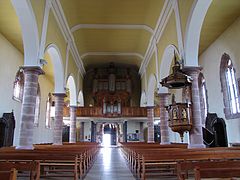Église Notre-Dame De L'Assomption, Bergheim
The current Bergheim church building was preceded by an earlier one, already dedicated to Mary, recorded in the year 705 and visited by Bernard of Clairvaux in 1146, while on his way from Basel to Worms to rally for the Second Crusade. That previous church was destroyed in 1287 during the great fire of Bergheim, which was started by the troops of Rudolf I of Germany.
The current Bergheim church was built from 1320 to 1347 and largely modified from 1718 to 1725, which accounts for the fact that it presents features both of Gothic architecture and of Neoclassical architecture.
The church is remarkable for its Gothic frescoes (both on the outside and the inside), which had been concealed in the 18th-century and rediscovered in 1959. A pair of Gothic statues from around 1460 are thought to be from the workshop of Nikolaus Gerhaert. The pipe organ is a 1903 instrument in a Baroque 1740 organ case.
Gallery
-
Main portal
-
Inside, looking east
-
Inside, looking west
-
Detail of the organ case
-
Fresco (14th century): Saint George and the Dragon
-
Fresco (15th century): Before the Crucifixion
-
Statue (ca. 1460): Anne and Mary
-
Statue (ca. 1460): Joachim
References
- ^ Base Mérimée: Eglise catholique de l'Assomption de la Bienheureuse Vierge Marie, Ministère français de la Culture. (in French)
- ^ "La paroisse Notre Dame de l'Assomption de Bergheim". paroisses-bergheim.fr. Retrieved 20 May 2019.
- ^ "Bergheim : Notre-Dame-de-l'Assomption : fragment du portail du Jugement dernier". Base numérique du patrimoine d'Alsace. Retrieved 20 May 2019.
- ^ Base Palissy: Ensemble de 2 statues : Saint Joachim, Education de la Vierge, Ministère français de la Culture. (in French)
- ^ "Orgue de Bergheim, église de la Vierge Marie". À la découverte de l'Orgue Orgues d'Alsace. Retrieved 20 May 2019.







